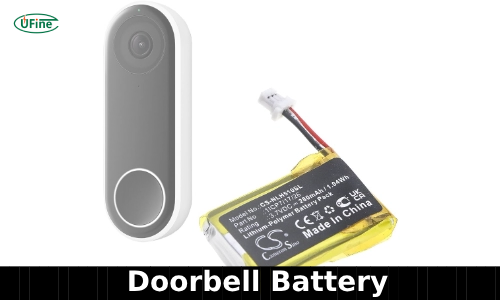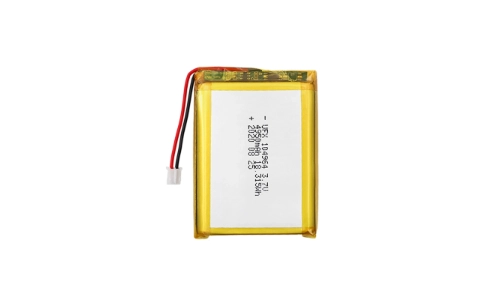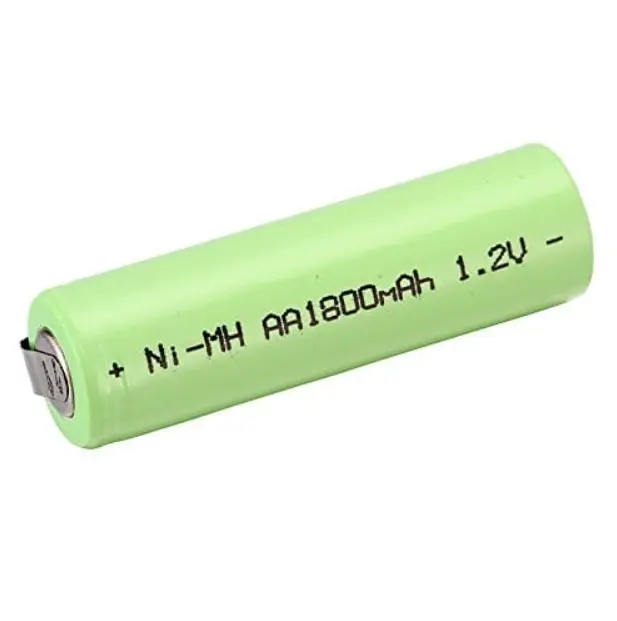Are you searching for the correct doorbell battery? This guide has all the answers. Discover what a doorbell battery is, the types available, the benefits of using high-quality options, and critical factors to consider when choosing one. Let’s explore together to ensure your doorbell operates smoothly and reliably when needed!
Part 1. What is a doorbell battery?
A doorbell battery serves as the power source for a doorbell system, enabling it to function independently of mains electricity. Typically, these batteries are compact and designed to fit within the confines of a doorbell unit. They come in various types, including alkaline, lithium-ion, and rechargeable options.
Key Characteristics:
- Power Source: Doorbell batteries provide the necessary electrical power for the doorbell to operate, ensuring it can ring when visitors press the button.
- Compact Design: They are small and lightweight enough to fit inside doorbell enclosures without taking up much space.
- Voltage Requirements: Depending on the specific doorbell model, most doorbell batteries operate at standard voltages such as 3 volts (V), 6V, or 12V.
- 장수: Depending on usage and type, doorbell batteries can last several months to years before needing replacement or recharging.
Part 2. Types of doorbell batteries
Alkaline Batteries
Alkaline batteries are standard and affordable options for doorbell power.
Pros:
- Widely available and easy to find in stores.
- Suitable for doorbells with moderate energy demands.
- Convenient for immediate use without charging.
Cons:
- Require frequent replacement, especially in high-usage scenarios.
- Not rechargeable, contributing to environmental waste.
Lithium-ion Batteries
They are known for their longevity and performance across various temperatures.
Pros:
- Long-lasting with stable performance in extreme temperatures.
- It is ideal for outdoor doorbells where temperature fluctuations occur.
- Lower self-discharge rate compared to other battery types.
Cons:
- Higher initial cost than alkaline batteries.
- You need specific disposal methods because of the lithium content.
Rechargeable Batteries
Nickel-metal hydride (NiMH) batteries are popular choices for their rechargeable nature.
Pros:
- Environmentally friendly with reduced waste from disposable batteries.
- Cost-effective over time due to multiple recharge cycles.
- Suitable for frequent use without constant replacement.
Cons:
- Require a compatible charger and periodic recharging.
- It can lose charge over time when not in use, requiring maintenance.
Part 3. Benefits of using high-quality doorbell batteries
Using high-quality doorbell batteries ensures your doorbell functions reliably and efficiently. Here are some key benefits:
1. Longer Lifespan
- Extended Use: High-quality batteries last longer, reducing the frequency of replacements.
- Consistent Performance: They provide stable power over time, ensuring your doorbell works whenever needed.
2. Enhanced Reliability
- Dependable Operation: Reliable batteries ensure your doorbell rings without fail, even in extreme weather conditions.
- Less Downtime: Fewer battery failures mean your doorbell is always ready to alert you of visitors.
3. Better Performance
- More robust Output: High-quality batteries offer better power output, ensuring clear and loud doorbell rings.
- Stable Voltage: They maintain a consistent voltage, preventing malfunctions or weak signals.
4. Safety
- Reduced Risk of Leakage: Premium batteries are less likely to leak, protecting your doorbell’s internal components.
- Built-In Protections: Many high-quality batteries have safety features to prevent overheating and short circuits.
5. Cost-Effectiveness
- Fewer Replacements: Although they may cost more upfront, their longer lifespan means you buy batteries less often.
- Energy Efficiency: High-quality batteries often provide better energy efficiency, giving you more power for each dollar spent.
6. Environmental Impact
- Less Waste: With fewer batteries to dispose of, you contribute less to landfill waste.
- Recyclable Options: Many high-quality batteries are recyclable, making them a greener choice.
7. Compatibility
- Optimal Fit: Premium batteries fit better and work more effectively with modern doorbells.
- Broad Range: They are available in various types, including alkaline, lithium-ion, and rechargeable options, to suit different needs.
Choosing high-quality doorbell batteries ensures your doorbell operates smoothly, providing peace of mind and reliable service. Investing in good batteries means fewer replacements, better performance, and enhanced safety for your home.
Part 4. Factors to consider when choosing doorbell batteries
When choosing doorbell batteries, several key factors will help ensure you select the best option for your needs:
1. Battery Type
- Alkaline: Common and affordable, but requires frequent replacements. Suitable for infrequent use.
- Lithium-ion: Longer-lasting and better for high-performance needs. Ideal for extreme temperatures.
- Rechargeable (NiMH): Environmentally friendly and cost-effective over time. Requires a charger and periodic recharging.
2. Voltage and Compatibility
- Correct Voltage: Match the battery voltage to your doorbell’s requirements (e.g., 3V, 6V, 12V).
- Compatibility: Ensure the battery type is compatible with your doorbell model. Check the manual or specifications.
3. Lifespan
- Long-lasting: Opt for batteries that offer a longer lifespan to reduce the frequency of replacements.
- Usage Frequency: Consider how often you use your doorbell; high-traffic areas may benefit from longer-lasting batteries.
4. Environmental Conditions
- Temperature Tolerance: Choose batteries that perform well in the temperature range your doorbell will experience.
- Humidity Resistance: Select batteries that handle moisture for doorbells in humid environments.
5. Brand and Quality
- Reputable Brands: Choose batteries from well-known brands known for quality and reliability.
- Customer Reviews: Review reviews to see how well the batteries have worked for others.
6. Cost
- Upfront vs. Long-term Cost: High-quality batteries may have a higher initial cost but often save money over time due to fewer replacements.
- Bulk Buying: If you have multiple devices, buying in bulk can reduce overall costs.
7. 환경 영향
- Recyclability: Select batteries that you can recycle to minimize environmental impact.
- Eco-friendly Options: Look for batteries with eco-friendly certifications and low environmental footprints.
Part 5. Tips for installing and maintaining doorbell batteries
Proper installation and maintenance of doorbell batteries can extend their life and ensure your doorbell functions correctly. Here are some practical tips:
1. Proper Installation
- Read the Manual: Refer to the doorbell’s manual for specific instructions.
- Correct Polarity: Insert batteries with the correct polarity (+ and -) indicated in the battery compartment.
- Secure Fit: Ensure batteries are firmly seated to avoid loose connections.
2. Regular Maintenance
- Check Battery Levels: Periodically check and replace batteries when low to avoid unexpected power loss.
- Clean Contacts: Use a dry cloth to clean battery contacts and terminals to prevent corrosion and ensure good conductivity.
- Inspect for Leaks: Regularly check for signs of leakage, which can damage the doorbell.
3. Optimize Battery Life
- Power-Saving Settings: Use power-saving modes if your doorbell supports them to extend battery life.
- Turn Off When Not in Use: Turn off the doorbell when away for extended periods.
- Avoid Extreme Temperatures: Protect the doorbell and batteries from extreme heat or cold.
4. Safety Precautions
- Use the Right Charger: Always use the recommended charger for rechargeable batteries.
- Avoid Mixing Types: Do not mix different types or brands of batteries, as this can cause leakage or damage.
- Proper Disposal: Dispose of old batteries according to local regulations to prevent environmental harm.
Part 6. FAQs about batteries for doorbell
How long does the ring doorbell battery last?
The Ring doorbell battery lasts 6 to 12 months on a single charge. This depends on usage and the number of motion events captured. The battery will drain faster if your doorbell records many motions or if you use it frequently. Cold weather can also affect the battery life, making it shorter.
How do you change the ring doorbell battery?
Changing the Ring doorbell battery is simple. Follow these steps:
- Remove the faceplate: Use the security screw tool that came with your Ring doorbell to unscrew the faceplate.
- Take out the old battery: Press the release tab to slide the battery out.
- Please insert the new battery. Slide it in until it clicks into place.
- Replace the faceplate: Put the faceplate back on and screw it in place using the security screw tool.
How do you charge the ring doorbell battery?
To charge your Ring doorbell battery, follow these steps:
- Please remove the battery: Press the release tab on the battery and slide it out.
- Connect to a power source: Plug the battery into a micro-USB charger. You can use any USB power source, such as a computer or a wall charger.
- Wait for the charge: A full charge takes about 5-10 hours. The battery has a small LED light that will turn green when fully charged.
- Reinsert the battery: Slide it back into the doorbell until it clicks into place.
How long does it take to charge the ring doorbell battery?
Typically, charging the Ring doorbell battery takes 5 to 10 hours. The time may vary based on the power source you use. A wall charger might charge faster than a computer USB port. Charge it thoroughly to get the most extended use between charges. The battery’s LED indicator will turn green when it’s ultimately charged.
관련 태그:
더 많은 기사

The Ultimate Guide to Remove Battery Corrosion
Learn how to remove battery corrosion, prevent future damage, and maintain battery health with our detailed guide.
How to Properly Discard Batteries and Protect the Environment?
Batteries power daily essentials but improper disposal poses risks. Learn to discard them responsibly for sustainable living and environmental protection.
Battery Manufacturing Process: A Comprehensive Guide
The battery manufacturing process creates reliable energy storage units from raw materials, covering material selection, assembly, and testing.
5 Creative Ways to Battery Organiser: Say Goodbye to Clutter
Tired of searching for the right battery? Discover five creative ways to organize batteries and keep your home clutter-free with this efficient storage guide.
Everything You Need to Know About 3.7v Battery
Discover the ins and outs of 3.7V batteries, including types, capacities, and applications. Learn how to choose the best one for your needs.







